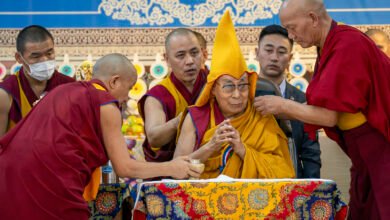
(RNS) — This week is the 40th anniversary of the Indian army’s heinous attack with tanks, artillery, missiles, helicopters and paramilitary forces on the Golden Temple complex in Amritsar, India, and more than 40 other Sikh shrines throughout the Punjab region.
The Golden Temple complex, or Darbar Sahib in Punjabi, consists of two main historical shrines: Harmandir Sahib (the spiritual center of the Sikh faith, built by its fourth founder), commonly referred to as the Golden Temple, and Akal Takht (the sovereign center of the Sikh faith, built by the sixth founder). The complex is the spiritual and sovereign center of faith of the Sikh community, akin to the Vatican for Catholics, the Kabba in Mecca for Muslims and Temple Mount in Jerusalem for Jews.
At the time of the attack, I was 19 years old and home for summer vacation in the small town of Tarn Taran, about 12 miles from Amritsar. Suddenly, curfew was declared, and overnight journalists were kicked out of Punjab. The following day, missiles fell in bursts not far off. I asked my father, a retired army man, what was happening. He guessed that the Indian military was shelling nearby Pakistan. Little did we know that the Indian army was attacking Darbar Sahib, Amritsar — a place that lives in the heart of every Sikh.
About two weeks after the assault, as a family, we visited the complex. I was devastated to see Akal Takht reduced to rubble, the Golden Temple riddled with bullets and the entrance gate to it partly blown apart. The Sikh Reference Library and Museum had been looted and burned to ashes in the attack.
During that visit, I somehow got separated from my parents for half an hour, or less. Wandering behind Akal Takht, gazing at the destruction, I suddenly froze. There in the rubble was a skull with a strand of black hair. The sight has been frozen in my memory since.
The military invasion of Darbar Sahib, code-named Operation Bluestar, came in the first week of June 1984, launched on the anniversary of the martyrdom of Siri Guru Arjan Sahib, the fifth founder of Sikhs in 1606, on the false pretext of arresting the holy man Sant Jarnail Singh Bhindranwale and his followers from the complex. Thousands of Sikhs — men, women and children — who had assembled for prayers were brutally gunned down.
Joyce Pettigrew, an anthropologist at Queen’s University in Belfast, wrote in her 1995 book “The Sikhs of Punjab,” “The army went into Darbar Sahib not to eliminate a political figure or a political movement but to suppress the culture of a people, to attack their heart, to strike a blow at their spirit and self-confidence.”

Sikh guards stand holding spears as devotees arrive to worship at the Golden Temple, in Amritsar, India, Sunday, Dec.19, 2021. (AP Photo/Prabhjot Gill)
The New York Times, in an editorial on June 8, 1984, stated that “(t)here was a nonviolent Sikh protest movement, but it was eclipsed when the Prime Minister rebuffed its demands … Since Indian independence in 1947, Sikhs have pleaded for greater autonomy and for specific recognition of their religion in the Constitution.”
Other operations began at the same time in rural areas of Punjab, just as ruthless, and lasted into the fall. “The pattern in each village appears to be the same,” wrote Mary Anne Weaver in The Christian Science Monitor in October. “The Army moves in during the early evening, cordons a village, and announces over loudspeakers that everyone must come out. All males between the ages of 15 and 35 are trussed and blindfolded, then taken away.”
Weaver reported that of the thousands who disappeared in Punjab, no list of the detained was given, meaning that “families don’t know if sons and husbands are arrested, underground or dead.”
Since 1984, visiting this Sikh historical shrine has become a traumatic experience for me. I am transported back to the day in 1984 when I wandered behind Akal Takht. I still look behind it to make sure the skull with a strand of hair is not still there. The image comes into my sleep often. The strand of black hair is a vivid reminder of a Sikh’s commitment not to cut our hair.
I later learned that my high school, Central School Amritsar, was turned into an illegal detention center at which pilgrims from Darbar Sahib complex were housed and tortured by Indian security forces. On visits to South Asia, I drive through Amritsar and think to loop by my former high school, but the trauma of 1984 has kept me from going inside. Years ago, I declined an invitation to my high school reunion — who would want to visit a former torture chamber for their class reunion?
For me, the attack on the Golden Temple was just the beginning of a formal assault on Sikhs, their places of worship and their identity by the Indian Government. In the last 40 years, more than a quarter-million Sikhs are reported to have been killed in Punjab and the rest of India.
The Sikh community’s appeals for transparency, accountability and restitution to the Indian government have been ignored; they are apparently not in the interest of peace. Justice for Sikhs in India has indeed been denied.
In the last decade, India has witnessed the rise of right-wing Hindu nationalism under the bigoted leadership of Prime Minister Modi, who is expected to win a third term this week. The tyranny of the majority is now well established in the “Land of Gandhi.” The recent inauguration of the Ram Temple on the grounds of an illegally demolished historic mosque is a symbol that Muslims, as well as Christians, Sikhs, Buddhists, Dalits and even liberal Hindus have been made second-class citizens.

Tarunjit Singh Butalia. (Photo courtesy Religions for Peace USA)
India desires to be a world power with a possible permanent seat at the U.N. Security Council with veto power. This will not be possible as long as the world’s largest democracy fails to live up to the promises of civilized nations that function under the rule of law and not the tyranny of the religious majority.
(Tarunjit Singh Butalia is executive director of Religions for Peace USA, vice chair of the board of Faith in Public Life and founding trustee of the Sikh Council for Interfaith Relations. The views expressed in this commentary do not necessarily reflect those of Religion News Service.)
Source link






